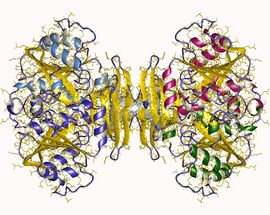Biology:Spermidine synthase
| spermidine synthase | |
|---|---|
 Spermidine synthase tetramer, Bacillus subtilis | |
| Identifiers | |
| Symbol | SRM |
| Alt. symbols | SRML1 |
| NCBI gene | 6723 |
| HGNC | 11296 |
| OMIM | 182891 |
| RefSeq | NM_003132 |
| UniProt | P19623 |
| Other data | |
| EC number | 2.5.1.16 |
| Locus | Chr. 1 p36-p22 |
Spermidine synthase is an enzyme (EC 2.5.1.16) that catalyzes the transfer of the propylamine group from S-adenosylmethioninamine to putrescine in the biosynthesis of spermidine. The systematic name is S-adenosyl 3-(methylthio)propylamine:putrescine 3-aminopropyltransferase and it belongs to the group of aminopropyl transferases. It does not need any cofactors. Most spermidine synthases exist in solution as dimers.[1]
Specificity
With exception of the spermidine synthases from Thermotoga maritimum and from Escherichia coli, which accept different kinds of polyamines, all enzymes are highly specific for putrescine.[2] No known spermidine synthase can use S-adenosyl methionine. This is prevented by a conserved aspartatyl residue in the active site, which is thought to repel the carboxyl moiety of S-adenosyl methionine.[3] The putrescine-N-methyl transferase whose substrates are putrescine and S-adenosyl methionine, and which is evolutionary related to the spermidine synthases, lacks this aspartyl residue.[4] It is even possible to convert the spermidine synthase by some mutations to a functional putrescine-N-methyltransferase.[5]
Mechanism
It is assumed that the synthesis of spermidine follows the Sn2 mechanism.[6] There is some uncertainty if the reaction occurs via a ping-pong or via a ternary-complex mechanism. Some kinetic data, but not all, suggest a ping-pong mechanism,[7] while the investigation of the stereochemical path of the reaction argues for a ternary-complex mechanism.[8] Prior to the nucleophilic attack of the putrescine onto the S-adenosylmethioninamine the putrescine has to be deprotonated rendering the nitrogen nucleophilic since the putrescine is protonated at physiological pH and is therefore inactive.
Inhibitors
The spermidine synthase can be inhibited by a wide variety of analogues of putrescine, S-adenosyl methioninamine and transition state analogues as Adodato (for further information see here)
See also
References
- ↑ "Aminopropyltransferases: function, structure and genetics". Journal of Biochemistry 139 (1): 1–9. January 2006. doi:10.1093/jb/mvj019. PMID 16428313.
- ↑ "Structure and mechanism of spermidine synthases". Biochemistry 46 (28): 8331–9. July 2007. doi:10.1021/bi602498k. PMID 17585781. https://figshare.com/articles/journal_contribution/2996425.
- ↑ "The crystal structure of spermidine synthase with a multisubstrate adduct inhibitor". Nature Structural Biology 9 (1): 27–31. January 2002. doi:10.1038/nsb737. PMID 11731804.
- ↑ "Putrescine N-methyltransferase--the start for alkaloids". Phytochemistry. Evolution of Metabolic Diversity 70 (15–16): 1708–18. 2009-10-01. doi:10.1016/j.phytochem.2009.06.012. PMID 19651420. Bibcode: 2009PChem..70.1708B.
- ↑ "Evolution of the key alkaloid enzyme putrescine N-methyltransferase from spermidine synthase". Frontiers in Plant Science 4: 260. 2013-01-01. doi:10.3389/fpls.2013.00260. PMID 23908659.
- ↑ Golding, B.T.; Nassereddin, l. K.; Billington, D.C.. "The Biosynthesis of Spermidine. Part I : Biosynthesis of Spermidine from L-[3,4-13C2] Methionine and L-[2,3,3-2H3] Methionine". J. Chem. Soc. Perkin Trans..
- ↑ "Polyamine synthesis in plants: isolation and characterization of spermidine synthase from soybean (Glycine max) axes". Biochimica et Biophysica Acta (BBA) - General Subjects 1475 (1): 17–26. June 2000. doi:10.1016/s0304-4165(00)00039-8. PMID 10806333.
- ↑ Golding, B.T.; Nassereddin, I.K. (1985). "The Biosynthesis of Spermidine. Part 3: The Stereochemistry of the Formationof the N-CH2, Group in the Biosynthesis of Spermidine". J. Chem. Soc. Perkin Trans.: 2017. doi:10.1039/P19850002017.
External links
- Spermidine synthase at BRENDA
- Spermidine synthase at ExPASy
- Spermidine+synthase at the US National Library of Medicine Medical Subject Headings (MeSH)
 |

